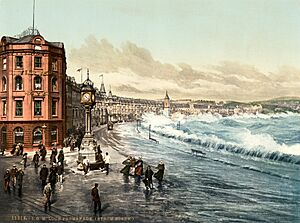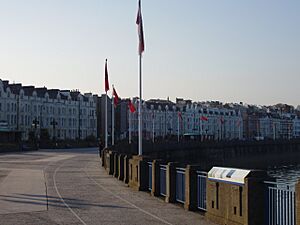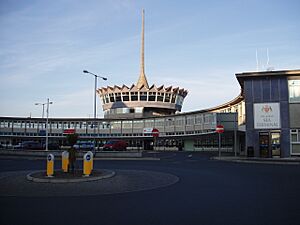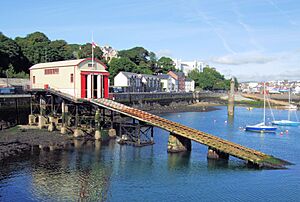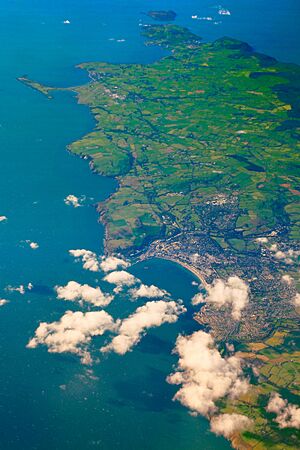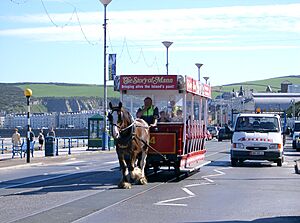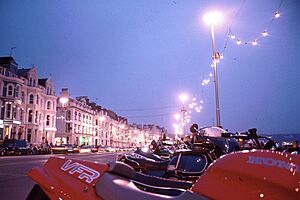Douglas, Isle of Man facts for kids
Quick facts for kids Douglas
|
|
|---|---|
| Capital city | |
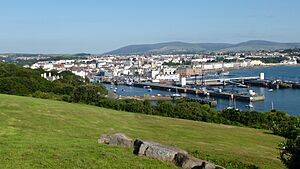 Douglas viewed from Douglas Head |
|
 Flag |
|
| Population | 26,677 (2021 Census) |
| OS grid reference | SC379750 |
| Parish | City of Douglas |
| Sheading | Middle |
| Crown dependency | Isle of Man |
| Post town | ISLE OF MAN |
| Postcode district | IM1 / IM2 |
| Dialling code | 01624 |
| Police | Isle of Man |
| Fire | Isle of Man |
| Ambulance | Isle of Man |
| House of Keys | Douglas North Douglas East Douglas South Douglas West |
| Website | www.douglas.im/ |
Douglas (called Doolish in the Manx language) is the capital city and largest town on the Isle of Man. It has a population of about 26,677 people (from the 2021 census). The city is located where the River Douglas meets the sea, in a wide, curving bay. The river is an important part of the city's harbour and main port for trade.
Douglas used to be a small village. But it grew very quickly in the 1700s because of its connections with the English port of Liverpool. In the 1800s, even more people moved there. Because of this growth, Douglas became the island's capital in the 1860s. The main courts, the Lieutenant Governor's home, and the island's parliament, Tynwald, all moved to Douglas from the old capital, Castletown.
Today, Douglas is the island's main centre for business, money, legal services, shipping, transport, shopping, and fun. The famous Isle of Man TT motorcycle races also start and finish here every year.
Contents
What's in a Name?
The name Douglas, and its Manx version Doolish, both come from an old Celtic word, *duboglassio-. This word means 'deep river'. The name of the city comes from the river it sits on. You can find similar place names in other parts of the British Isles, like Dawlish and Dulais.
Douglas Through Time
Early Days
We don't have many old records, but some discoveries hint at Douglas's early importance. A bronze weapon was found in the city centre, and a large Viking treasure was found nearby. These show that people lived and traded here a long time ago.
Douglas is mentioned twice in an old book called the Chronicle of the Kings of Man and the Isles. In 1190, monks stayed here for four years. Then, in 1313, Robert the Bruce, a Scottish king, spent a night at a "monastery of Duglas" before taking over Castle Rushen. These mentions might refer to the area where the Nunnery is now, a bit upriver from the port.
By 1511, there were only 13 families living in Douglas. Many buildings were just "chambers" used by people from other parts of the island. This suggests Douglas started as a port for trade, especially for herring fishing and moving goods in and out.
How Douglas Grew
In 1681, Douglas was called "the place of greatest resort" on the Isle of Man. By 1705, it was clear the town was growing. It was becoming more important for people to live there, for markets, and for defence. The town really grew in the next 60 years. Big houses for merchants, large warehouses, and piers were built. This was partly because of "running trade," which was another name for smuggling.
After 1765, Douglas also benefited from trade across the Atlantic Ocean. This was helped by working with the port of Liverpool. Important merchants like the Murreys and Moores became well-known. Douglas also became popular because living costs were low, and it was a good place for people who owed money or retired officers. The town's natural harbour helped it grow a lot. Between 1710 and 1784, Douglas's population grew from about 800 to nearly 2,500 people.
In the 1800s, Douglas grew even more, just like other towns in the United Kingdom during the Industrial Revolution. More and more people started visiting for holidays from the early 1800s. By the 1870s, Douglas was a top holiday spot. However, with more people came problems like dirty conditions and poor housing.
To make things better, oil and gas lamps appeared in the 1820s and 1830s. The first hospital was built in 1850. In 1832, the famous Tower of Refuge was built in Douglas Bay. It was a shelter for sailors who were shipwrecked. Douglas faced many challenges in the early 1800s, including sicknesses like cholera.
Douglas became the island's capital in 1869, taking the title from Castletown. This showed how important Douglas had become. At first, some people in Douglas didn't want a town council. But in 1860, Douglas elected its first town council. This council worked hard to solve the town's problems, like the sewage system, which was mostly fixed by 1869.
The council also changed the town's old buildings, which were not good for tourists. Many old, narrow streets were cleared away between the 1870s and 1920s to make way for new roads and better areas. The town was changed a lot to make it easier for tourists. For example, the Loch Promenade was built in 1878. In 1870, Douglas had 60,000 visitors a year. By 1884, this number grew to 182,000!
Sea Connections
The first regular ferry services between Douglas and Whitehaven started in the 1750s. Later, in 1819, steamships began to offer better services. The Isle of Man Steam Packet Company was formed in 1830. This company greatly improved ferry services and helped both cargo and tourist travel grow.
The Royal National Lifeboat Institution (RNLI) has a lifeboat station in Douglas. The first one opened in 1802. In 1825, Douglas was one of the first places to get a special lifeboat, thanks to Sir William Hillary. He was the person who started the RNLI. There are three memorials to Sir William in Douglas. One is in St George's Church, another on Loch Promenade, and the third near the Tower of Refuge he built.
Modern Douglas
During the First and Second World Wars, Douglas was home to camps for people from enemy countries. Many guest houses on the Promenade were used for this purpose. The island's war heroes are remembered at the Douglas War Memorial.
Today, Douglas is the main centre for the island's financial services industry. It also has the main shopping areas.
Douglas is famous as the birthplace of the Gibb brothers – Maurice, Robin, and Barry – who formed the famous music group, the Bee Gees.
The city was also home to the Summerland leisure centre, which sadly had a big fire in 1973.
In 2011, Douglas hosted the 2011 Commonwealth Youth Games, a big sports event for young people.
On May 20, 2022, it was announced that Douglas would officially become a city. This was part of the Platinum Jubilee Civic Honours for Queen Elizabeth II. The official document was presented by Queen Camilla on March 20, 2024.
Where is Douglas?
Douglas is on the east side of the island. It's located where two rivers, the Dhoo and the Glass, join together to form the River Douglas. This river then flows into Douglas Bay. The city is in a gently sloping valley, surrounded by hills.
Douglas is close to other villages. Onchan is to the north-east and is almost connected to Douglas. Union Mills is to the west.
Weather in Douglas
The closest weather station to Douglas is at Ronaldsway, about 7 miles south-west. The highest temperature ever recorded there was 28.9°C (84.0°F) in July 1983. On average, Douglas gets about 14.5 days of air frost each year. The lowest temperature ever recorded was -9.1°C (15.6°F) in December 1961.
How Many People Live Here?
The 2021 census showed that Douglas has 26,677 people. This is a bit less than the 27,938 people in 2011. In 2001, there were 25,347 people. Douglas is home to about 31.73% of the Isle of Man's total population.
How Douglas is Run
Douglas elects eight members to the House of Keys. This is the lower house of Tynwald, the Isle of Man's parliament. The local government for Douglas is the Douglas Corporation. It has 18 elected councillors who form the Douglas City Council.
Getting Around Douglas
Douglas is the main centre for the island's bus network. You can catch frequent buses to places like Port Erin, Peel, and Ramsey, as well as local services around the city. Douglas also has the starting points for the island's two main railway lines: the steam railway to Port Erin and the electric tramway to Ramsey.
The Isle of Man Sea Terminal is also in Douglas. From here, the Isle of Man Steam Packet Company runs regular ferries to Heysham and Liverpool (or Birkenhead in winter). Sometimes, there are also services to Dublin and Belfast.
Media in Douglas
The Isle of Man's three main radio stations – Manx Radio, Energy FM, and 3FM – are all based in Douglas.
For local TV news, people watch BBC North West Tonight on BBC One and ITV Granada Reports on ITV1.
Douglas also has local newspapers: the Isle of Man Examiner, the Isle of Man Courier, and the Manx Independent.
Learning in Douglas
Education in Douglas goes way back to the late 1600s. There was a schoolmaster and a "petty school" in 1675.
The official history of education in Douglas began when Bishop Thomas Wilson set up the Douglas Grammar School. William Dixon gave his old family home for the school in 1714. The Bishop also raised money to support it. The Grammar School's master was often also the Chaplain of the new Chapel of St Matthew.
Today, Douglas has two high schools: Ballakermeen High School and St. Ninian's High School. There are also many primary schools. The University College Isle of Man and the International Business School are also located in Douglas.
Fun Things to See and Do
Douglas has many interesting places to visit:
- The Tower of Refuge is a small castle-like building on Conister Rock in Douglas Bay. It was built by Sir William Hillary to help sailors who were shipwrecked.
- Douglas Head has the Grand Union Camera Obscura. This is a special room that uses mirrors and lenses to project a view of the outside world onto a screen. It's been restored and is open in summer.
- The horse-drawn trams run along the promenade from the Villa Marina to the Manx Electric Railway station from spring to early autumn.
- Steam trains travel 15 miles from Douglas railway station to Port Erin in the south of the island.
- The Grandstand on Glencrutchery Road is where the annual TT Races start and finish.
- The Gaiety Theatre and the Villa Marina are popular places for shows, from rock concerts to plays and ballet. The Gaiety Theatre is a beautiful old building from 1900.
- The Manx Museum in Kingswood Grove has many important items about the Isle of Man's history and culture. You can see things like the Calf of Man Crucifixion Stone and Viking treasures.
- The Jubilee clock is a street clock built in 1887 to celebrate Queen Victoria's 50 years as queen. It's at the bottom of Victoria Street.
- Other interesting buildings include Isola restaurant and the Douglas Hotel, which were merchants' houses from the 1700s. The Castle Mona was a large seaside mansion built in 1804. The Loch Promenade is a curving row of old boarding houses from the 1870s.
- The breakwater extension was finished in 1983.
- The Sunken Gardens on Loch Promenade were created when the promenade was made wider around 1900.
Sports in Douglas
Douglas is the start and finish point for the famous Isle of Man TT motorcycle race.
The Isle of Man Cricket Club was formed in 1930. It became a member of the International Cricket Council in 2004.
The National Sports Centre (NSC) is a big sports complex with an athletics stadium on Pulrose Road. It's owned by the government and run by Manx Sport & Recreation. The King George V Bowl is another multi-use stadium owned by Douglas City Council.
A free Parkrun event happens in Nobles Park every Saturday.
Douglas is home to eight of the seventeen football clubs in the Isle of Man Football League:
| Club | Home ground |
|---|---|
| Corinthians A.F.C. | Nobles Park |
| Douglas and District F.C. | Groves Road, Pulrose |
| Douglas Royal F.C. | National Sports Centre, Groves Road |
| Gymnasium F.C. | Tromode Park, Tromode Road |
| Police A.F.C. | Groves Road, Pulrose (shared) |
| Pulrose United A.F.C. | |
| St Georges A.F.C. | Glencrutchery Road |
| St Marys A.F.C. | The Bowl, Pulrose Road |
Douglas Rugby Club and Vagabonds Rugby Club are also based in the city. Their main teams play in English competitions, while their reserve teams play in the Manx Rugby competition.
Famous People from Douglas
Many interesting people have come from Douglas:
Science and Technology
- Professor Edward Forbes (1815–1854) – a Manx naturalist.
- Gordon Manley (1902–1980) – an English climatologist (someone who studies climate).
- Dorothy Pantin (1896–1985) – the first woman doctor and surgeon on the Isle of Man.
- Derek Charles Robinson (1941–2002) – a physicist who worked on fusion power.
Public Service and Business
- Commander Robert Benjamin Young (1773–1846) – a Royal Navy officer who saw the battle of Trafalgar.
- Thomas Edward Brown (1830–1897) – a scholar, teacher, poet, and theologian.
- Admiral Sir Thomas Hugh Binney (1883–1953) – a senior officer in the Royal Navy and Governor of Tasmania.
- Bertram Kelly (1884–1976) – brought electricity to the Isle of Man.
- Chris Killip (born 1946) – a Manx photographer who teaches at Harvard University.
- Phil Gawne (born 1965) – a former member of the House of Keys and government minister.
Arts and Entertainment
- W. Clucas Kinley (1866–1920) – Manx playwright and journalist.
- Harry Korris (1891–1971) – a British comedian and actor.
- Toni Onley (1928–2004) – a Manx painter known for his landscapes.
- Bryan Kneale (born 1930) – a Manx artist and sculptor.
- Sir Barry Gibb (born 1946) – a singer, songwriter, and the last living member of The Bee Gees.
- Maurice Gibb (1949–2003) – a singer, songwriter, and member of the Bee Gees.
- Robin Gibb (1949–2012) – a singer, songwriter, and member of the Bee Gees.
- Francis Magee (born 1959) – an Irish-Manx actor, known for his role in EastEnders.
- Jamie Blackley (born 1991) – a British actor, known for the film If I Stay.
- Amy Jackson (born 1992) – a Manx-born actress who appears in Indian movies.
- Joe Locke (born 2003) – a Manx actor, known for his role in the Netflix series Heartstopper.
Sport
- Dave Moore (born 1966) – a motorsport commentator.
- Tim Kneale (born 1982) – a Manx sport shooter.
- Mark Cavendish (born 1985) – a Manx professional road racing cyclist.
- Conor Cummins (born 1986) – a Manx motorcycle road racer.
- Kieran Tierney (born 1997) – a Manx-born, Scottish international footballer who plays for Arsenal F.C.
- Adam Long (born 2000) – a Manx professional footballer.
Panoramas of Douglas
See also
 In Spanish: Douglas (Isla de Man) para niños
In Spanish: Douglas (Isla de Man) para niños



